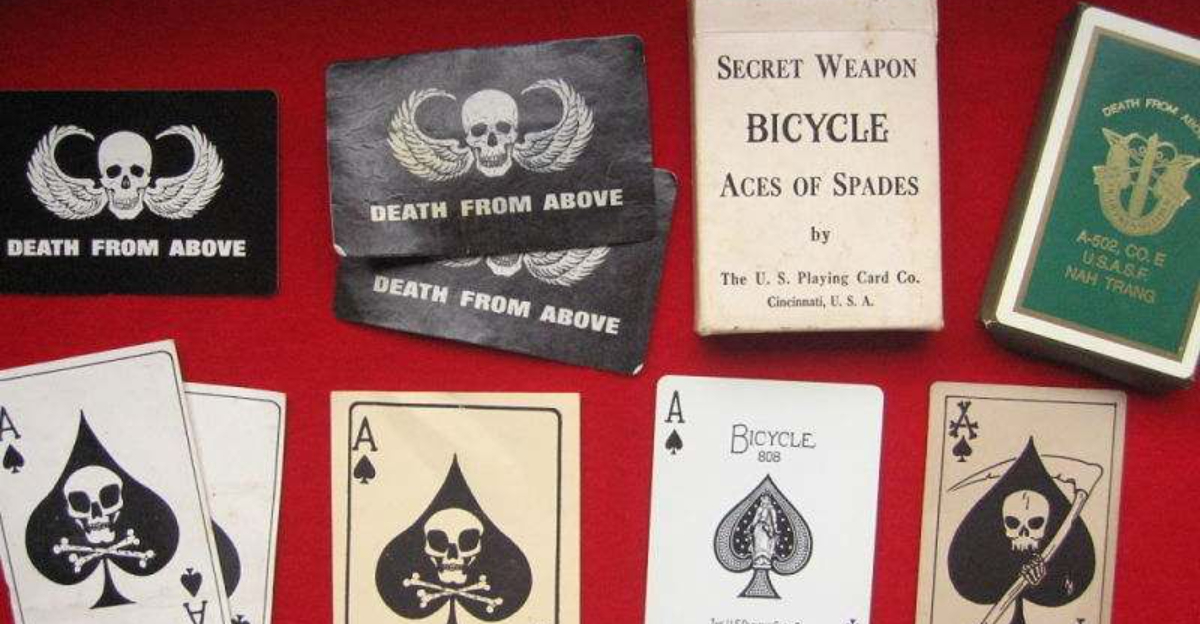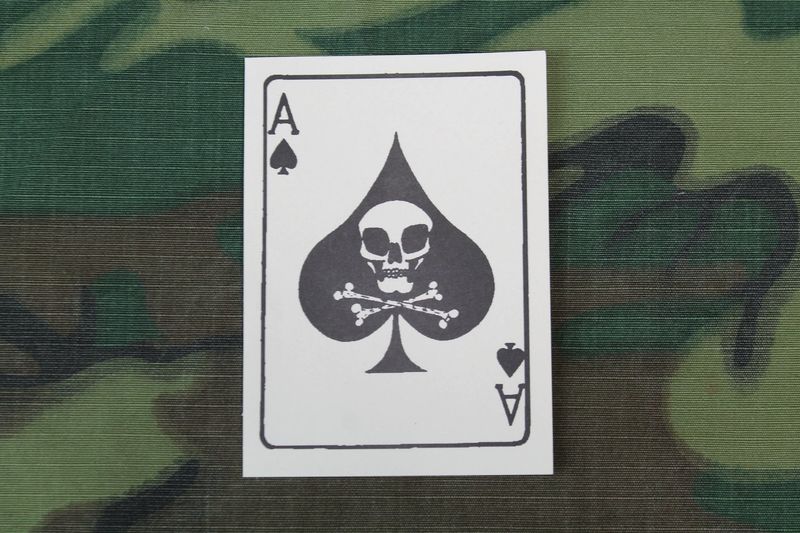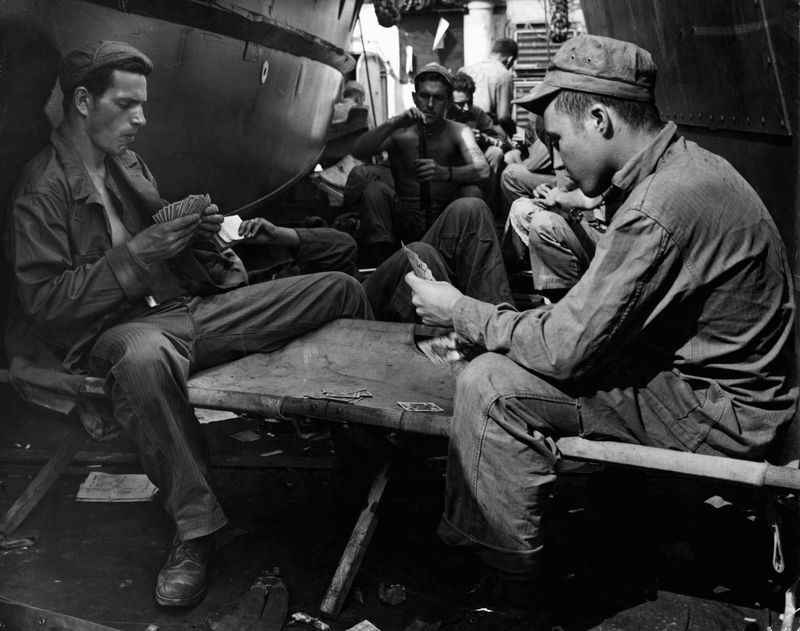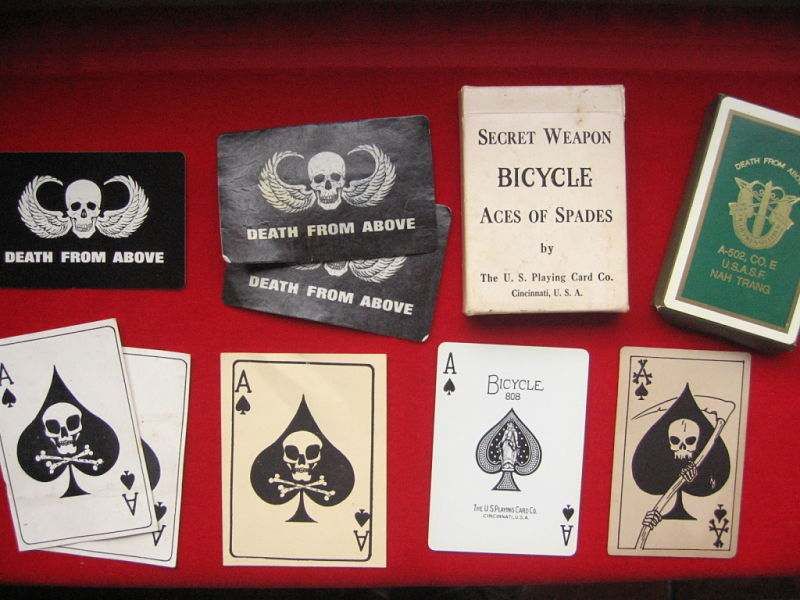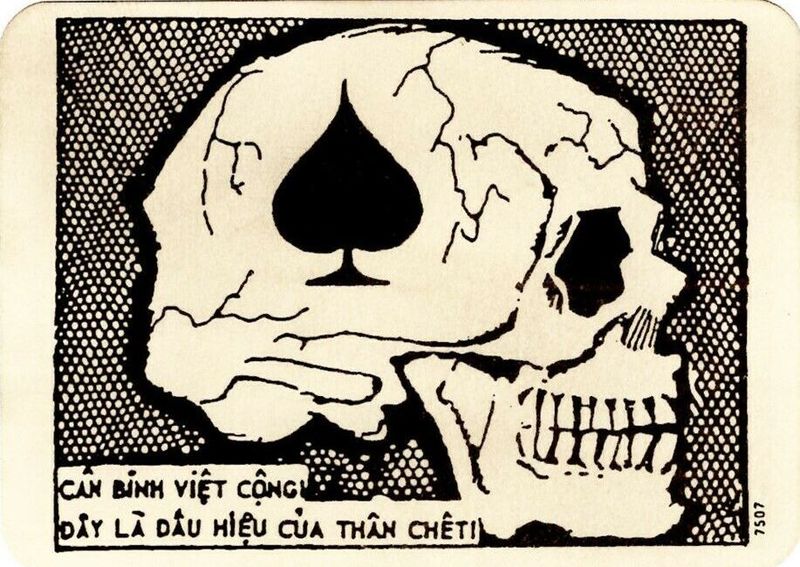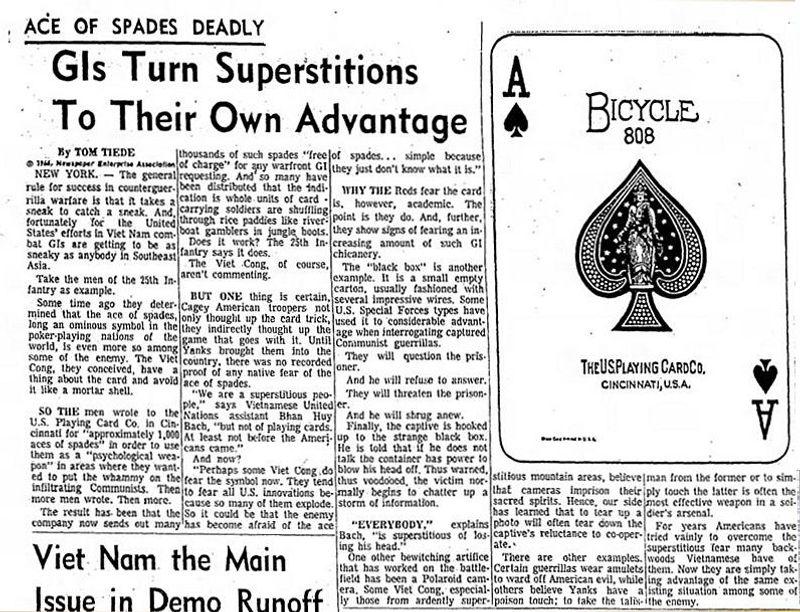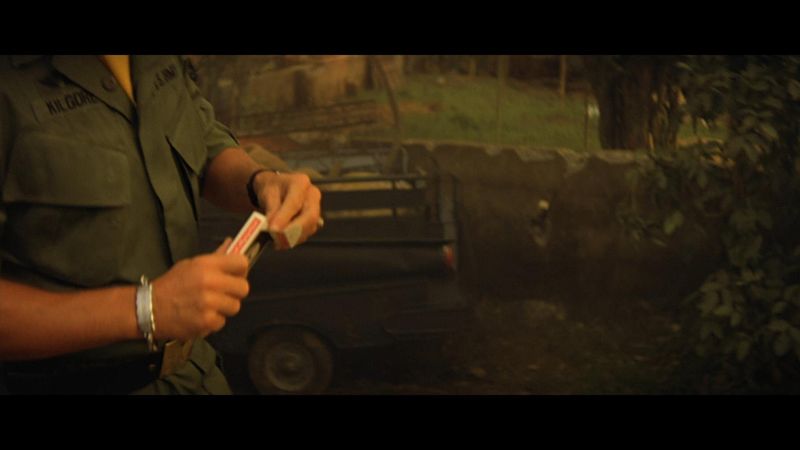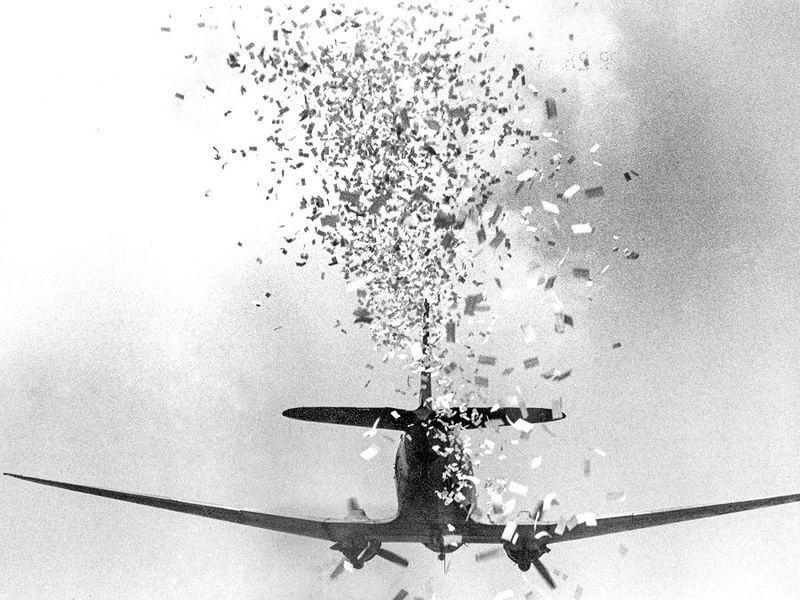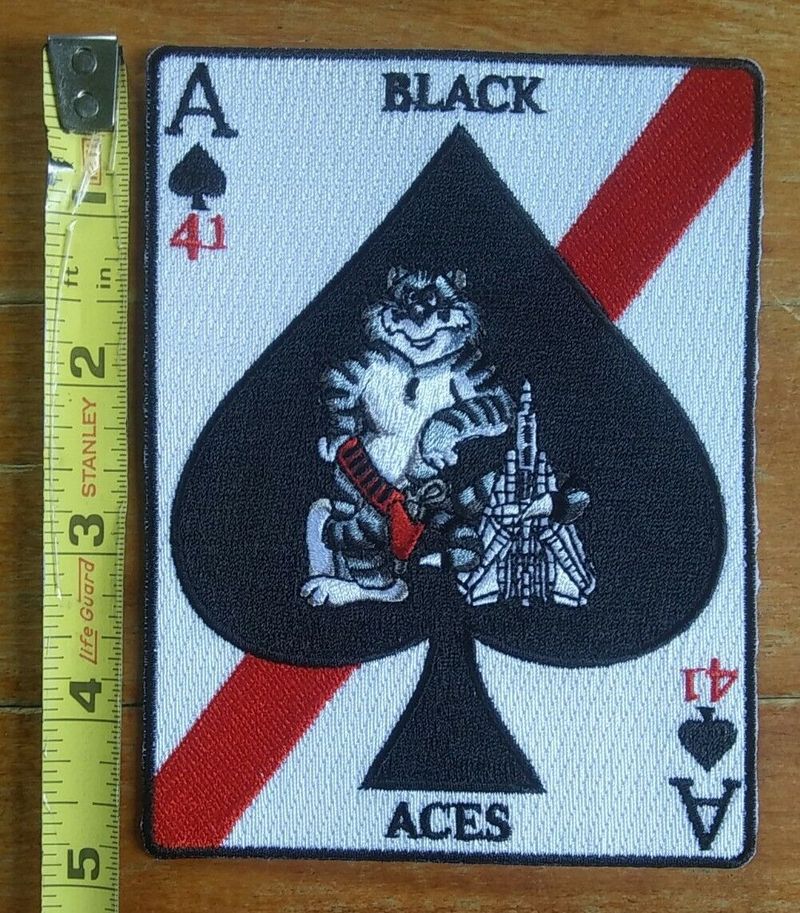During the Vietnam War, American soldiers used playing cards in an unexpected way that went beyond card games. They turned the Ace of Spades into a psychological weapon against the enemy. These “death cards” left on bodies of fallen Viet Cong soldiers were meant to strike fear in the hearts of their comrades. The practice became widespread and remains one of the war’s most distinctive psychological warfare tactics.
1. Origin of the “Death Card”
The sinister tradition began when American troops discovered Vietnamese soldiers feared the Ace of Spades. Soldiers seized this cultural superstition as an opportunity.
Many troops carried a single Ace of Spades specifically for marking enemy bodies. The card, already associated with death in Western playing card decks, gained new meaning as a calling card left by American forces.
Unlike formal military tactics, this practice emerged organically among frontline soldiers seeking ways to demoralize the enemy. The intimidation tactic spread quickly through different units as stories of its effectiveness circulated among American forces.
2. Psychological Warfare Tactic
Playing cards transformed into weapons of fear when soldiers discovered Vietnamese cultural beliefs. Intelligence officers learned many Vietnamese associated the spade symbol with bad luck and death – making it perfect for psychological operations.
Soldiers would strategically place these cards in villages, on trails, and most notably, on the bodies of fallen enemy combatants. The goal wasn’t just intimidation but creating a mystique around American forces.
Field reports suggested the tactic worked, with some enemy units avoiding areas where cards had been found. This simple paper tool required no ammunition but helped amplify American psychological dominance on the battlefield.
3. Formal Request for Decks
The grassroots psychological tactic gained official recognition in February 1966. Officers from Charlie Company, 2nd Battalion, 35th Infantry Regiment sent an unusual supply request to the U.S. Playing Card Company back home.
Their letter requested 1,000 decks containing only the Ace of Spades – a peculiar order that caught the company’s attention. The playing card manufacturer responded patriotically, shipping the requested cards labeled “BICYCLE SECRET WEAPON” completely free of charge.
This commercial support transformed an informal soldier practice into a supplied military tactic. Soon other units followed suit with similar requests, turning playing cards into standardized psychological warfare equipment.
4. Unit-Produced Variants
Standard playing cards eventually gave way to custom-designed versions with more intimidating imagery. The 6th Psychological Operations Battalion became the primary producer of these specialized cards at the request of Special Forces units.
These weren’t ordinary playing cards – they featured skulls, threatening messages in Vietnamese, and warnings like “Death awaits Viet Cong cadres.” Some designs incorporated unit insignias or grim reaper imagery to maximize psychological impact.
Special Forces teams would request specific designs tailored to local superstitions in their operating areas. The cards became calling cards for particular units, with enemy fighters learning to associate certain designs with specific American forces they feared most.
5. Evolution from WWII Symbolism
Before becoming a symbol of fear, the Ace of Spades served as a lucky charm. The famed 101st Airborne Division first painted it on their helmets during World War II parachute drops over Normandy, believing it brought good fortune in battle.
By Vietnam, this same symbol underwent a dramatic transformation. What once represented protection for American soldiers now projected death toward their enemies.
Soldiers who had fathers or uncles in WWII sometimes noted the irony of the symbol’s evolution. The card’s journey from personal talisman to psychological weapon reflected broader changes in warfare tactics between the two conflicts, with Vietnam emphasizing psychological operations more heavily.
6. Cultural Impact & Media
Francis Ford Coppola’s 1979 film “Apocalypse Now” immortalized death cards in popular culture. When Captain Willard mentions finding an Ace of Spades on a body, millions of viewers learned about this psychological warfare tactic for the first time.
Rock bands like Motörhead later adopted the symbol, with their 1980 “Ace of Spades” hit further cementing the card’s association with death and danger. Military memorabilia collectors now pay premium prices for authentic Vietnam-era death cards.
Veterans’ accounts of using these cards appear in countless documentaries and books about the war. This simple playing card has become one of the conflict’s most recognizable symbols, representing the psychological dimension of a deeply complex war.
7. Broader Use in PsyOps
Death cards functioned as just one component in America’s psychological warfare arsenal. Airplanes and helicopters would drop thousands of these cards over villages alongside propaganda leaflets, creating a multi-layered messaging approach.
Radio broadcasts sometimes referenced the cards, suggesting that anyone who found one was marked for death. This coordinated approach magnified the psychological impact beyond what cards alone could achieve.
The cards proved remarkably cost-effective compared to other tactics. A single deck could affect dozens of enemy fighters without expending ammunition or risking American lives, making them popular with commanders looking to maximize psychological pressure while conserving resources.
8. Post-War Legacy
The psychological impact of death cards extended far beyond the war’s end in 1975. Veterans brought the practice home, with some motorcycle clubs and veterans’ groups adopting the Ace of Spades as their symbol.
Commercial opportunities followed with companies like Dart Flipcards releasing their 1988 “La Carte de Revenge” trading card series. These collectibles featured dramatic artwork depicting death card scenarios, allowing civilians to own a piece of this dark military tradition.
Military academies now study death cards as a case study in low-tech psychological operations. Modern soldiers in Iraq and Afghanistan occasionally revived the practice, demonstrating how this Vietnam-era tactic continues influencing military psychological operations decades later.
